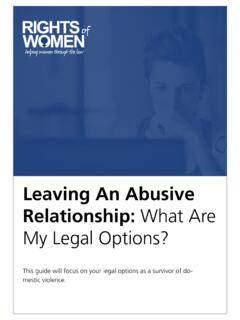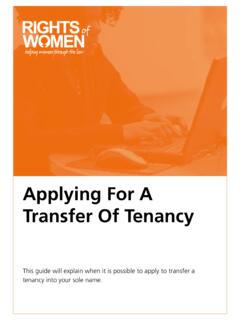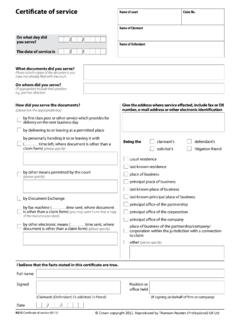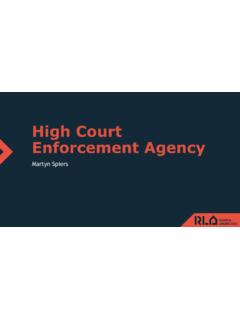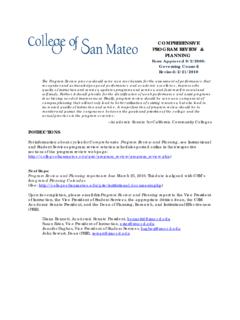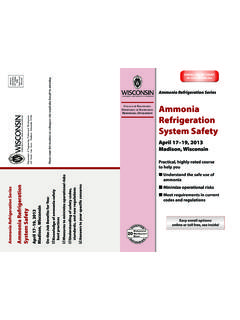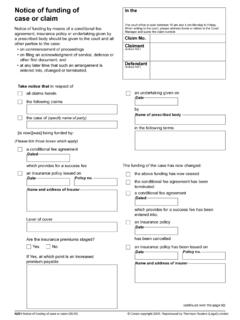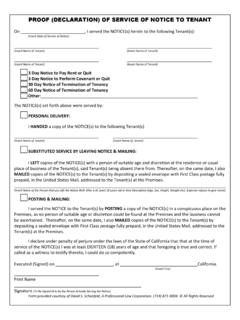Transcription of Harassment and the law - rightsofwomen.org.uk
1 What is Harassment ?The law states that Harassment is when aperson behaves in a way which is intended tocause you distress or alarm. The behaviourmust happen on more than one occasion. Itcan be the same type of behaviour ordifferent types of behaviour on eachoccasion. For example, one text messageintended to distress you is not text messages may be Harassment . Onetext message and one phone call may also be can include things your abuserhas said or done. The incidents could havehappened recently or they could havehappened months apart. When deciding whether your abuser sbehaviour is Harassment , the court willconsider whether a reasonable person, whohad the same information your abuser had,would think that it is Harassment .
2 Anincident of Harassment could be a range ofthings, for example: a text, answer-phone message, letter oremail a comment or threat standing outside someone s house ordriving past it an act of violence damage to someone else s property maliciously and falsely reporting you to thepolice when you have done nothing wrongWhat is putting someone infear of violence?Putting someone in fear of violence is whensomeone says or does two or more thingsthat make you fear that violence will be usedagainst you. The law states that a person isguilty of putting you in fear of violence if areasonable person, who had the sameinformation your abuser had, would think hisbehaviour would cause you to fear an emergencyIn an emergency you can contact the policefor assistance by dialling 999 or text phoning0800 112 999.
3 The police may be able toattend the scene of the incident to protectyou from further abuse and/or to arrest yourabuser (see our legal guide Reporting anoffence to the police: a guide to criminalinvestigations). For other support andprotection see Useful contactsat the end ofthis it is not an emergency then you cancontact the police by going to your localpolice station, or calling your local policestation by dialling criminal offences ofharassment and puttingsomeone in fear of violenceIt is a criminal offence for someone to harassyou or to put you in fear of violence.
4 If youexperience any of these forms of abuse youcan report it to the police. For information onwhat happens if you report an offence to theHarassment and the lawIt is a criminal offence in England and Wales for someone to harass you orput you in fear of violence. This legal guide is designed to give informationabout the ways in which the law can protect you. police and the criminal justice process seeour legal guides Reporting an offence tothe police: A guide to criminalinvestigationsand From charge to trial: Aguide to criminal proceedings. If he is found guilty of an offence he can besentenced to a term in prison or made to paya fine or both.
5 Harassment warningsSometimes if the police decide that they arenot going take any further legal actionagainst your abuser, they may give him aninformal Harassment warning. Harassmentwarnings are also known as harassmentwarning notices and police informationnotices (PINs).This is a warning which tells your abuserabout the law in relation to Harassment , andthat if there are similar reports in the futurethe police might take action against abuser may be asked to sign thewarning. This does not mean that he admitsto harassing you, it just confirms that he hasreceived the warning.
6 However, if you doreport his harassing behaviour to the policeagain in the future, then the notice can beused to show that he knew that hisbehaviour is ordersIf the police charge your abuser and the casegoes to the criminal courts then the courtmay make a restraining order to protect criminal court can make the restrainingorder whether or not your abuser isconvicted (found guilty). A restraining order is a court order whichprohibits your abuser from doing certainthings such as contacting you or attendingyour place of work or home (breaking) a restraining order is acriminal offence.
7 The court will make the order if the judgethinks it is justified. Sometimes the CrownProsecution Service (CPS) will ask the judgeto make a restraining order but it will be upto the judge to decide. You cannot apply tothe criminal courts for a restraining orderyourself. If you want to make your ownapplication to stop your abuser from doingsomething then you can apply for aninjunction. See Harassment injunctionsbelow. Coercive controlIf your abuser is someone who you are in anintimate relationship with or is a familymember or ex-partner who you live with,they may be guilty of the criminal offence ofcoercive control.
8 Someone is guilty ofcoercive control if they repeatedly orcontinuously engage in behaviour towardsyou that is coercive or controlling and theyknow or ought to know that the behaviourwill have a serious effect on you. If you are experiencing coercive control youcan report this to the police. For moreinformation please see our legal guideCoercive control and the injunction is a court order which canforbid your abuser from doing certain thingssuch as being physically violent, contactingyou directly or indirectly (by making someoneelse contact you), or going to your homeaddress, place of work or children s on your relationship with yourabuser you can apply for an injunction underthe Protection from Harassment Act 1997 orthe Family Law Act 1996.
9 Non-molestation ordersIf you are associatedto your abuser youmay prefer to apply to the Family Court for adomestic violence injunction called a non-molestation order. These injunctions areeasier to apply for, and there is no court feefor the application. Legal aid is also availablefor this are associated to your abuser if you andyour abuser: are or were ever married, engaged or in acivil partnership are or were living together (including asflatmates, partners, relations) are relatives, including: parents, children,grandparents, grandchildren, siblings,uncles, aunts, nieces, nephews or firstcousins (whether by blood, marriage, civilpartnership or cohabitation) have a child together or have or hadparental responsibility for the same child are or were in an intimate personalrelationship of significant durationFor more information see our legal guideDomestic violence injunctions.
10 Harassment injunctionsIf you are not associated to your abuser, or ifyou do not want to apply for a non-molestation order, then you can apply for aharassment injunction under the Protectionfrom Harassment Act 1997. You can applyfor an injunction against any person who hasharassed or stalked you or put you in fear ofviolence by deliberately causing you distresson two or more occasions. This is differentfrom restraining orders which can be made inthe criminal courts. This is an injunction thatyou apply for yourself in the civil courts, suchas a county of injunctionsInjunctions can prohibit someone frombehaving in a certain way.



